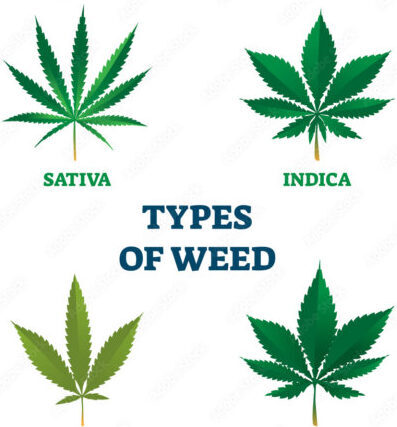Photo courtesy of Adobe Stock.
In the dynamic spectrum of cannabis species, strain classification into indica, sativa, ruderalis, and hybrid has long served as a compass for enthusiasts seeking a diversity of options. The indica, sativa, ruderalis, and hybrid strains have long been the cornerstone of this classification system, offering unique characteristics and effects. These distinctions have shaped the preferences and experiences of cannabis users worldwide. The classifications of indica, sativa, ruderalis, and hybrid have become deeply ingrained in cannabis culture. Indica strains are often associated with sedating effects, making them a popular choice for relaxation and sleep aids.
On the other hand, Sativa strains are celebrated for their uplifting and energizing properties, which are ideal for daytime use and creative endeavors. Ruderalis, though less common, is known for its hardiness and resilience, and it is often utilized in breeding programs for its auto-flowering traits. Hybrids, the offspring of carefully selected parent strains, offer a harmonious blend of characteristics, catering to a wide range of preferences and needs. In this blog post, we’ll explore the four different cannabis species, delving into the therapeutic potential of each species and its role in managing neurological conditions.
Table of Contents
ToggleIndica
The primary and widespread species of cannabis plant, indica strains, are often associated with a calming and relaxing effect on the mind and body by alleviating stress, inducing sleep, and soothing aching muscles. Their effects make them popular for evening or nighttime, providing a mellow and tranquil experience. Typically, indica plants are shorter and bushier, with broader leaves and compact stature, distinguishing them from sativa plants. They are famous for alleviating various medical conditions involving the neurological system. Additionally, it’s valuable for reducing anxiety and stress, providing much-needed relief to individuals suffering from anxiety disorders and chronic stress. Furthermore, compounds in indica strains, such as THC (tetrahydrocannabinol) and CBD (cannabidiol) cannabinoids, interact with the body’s endocannabinoid system (ECS) to regulate mood and emotions.
Sativa
On the opposite end of the spectrum, sativa is renowned for its energizing and uplifting effects on the mind and body. Sativa plants are usually taller, with thinner structures and narrower leaves, and are often favored for daytime use. They are easily distinguishable from indica strains. Sativa plants are associated with increased creativity, focus, and a euphoric sense of well-being, making them a go-to choice for those seeking a boost in motivation without the sedative effects of indica. More importantly, sativa can alleviate symptoms of anxiety and depression in individuals who suffer from neurological conditions. Some sativa strains can uplift and have euphoric effects that can promote a sense of well-being and relaxation, thus reducing symptoms of anxiety and depression as well as anti-inflammatory conditions.
Ruderalis
Ruderalis is a lesser-known cannabis strain but equally intriguing as a subspecies that originated in regions with harsh climates in Russia and Eastern Europe. They are distinctive for their auto-flowering trait, meaning it doesn’t rely on changes in light cycles to transition from vegetative to flowering stages. In terms of therapeutic potential, ruderalis strains are generally lower in THC and CBD than sativa and indica varieties. They have gained attention for their resilience and short growth cycle, making them suitable for specific cultivation environments that are valuable for breeding. In addition, regarding therapeutic potential, ruderalis can produce CBD strains that may treat neurological conditions like epilepsy and some neurodegenerative disorders.
Hybrid
Hybrid strains result from cross-breeding indica and sativa genetics, aiming to capture the best of both worlds. This hybrid combination encompasses various effects, terpenes, and growth characteristics, allowing cultivators to tailor strains to specific preferences and therapeutic potentials. Also, depending on the particular hybrid, it may exhibit traits such as height differences, leaf structures, and flowering times. Furthermore, hybrids can be Indica-dominant, Sativa-dominant, or balanced, offering a customized experience that suits various occasions and individual needs. In addition, the hybrid combination of THC and CBD cannabinoids can provide a broad range of benefits for neurological health for individuals with pain relief and reduced inflammation to improve their overall well-being.
Managing neurological disorders:
- CBD-dominant hybrid strains have been proven to be effective in reducing seizures in some patients with epilepsy, and their effects may be beneficial in slowing down Alzheimer’s and Parkinson’s neurodegenerative diseases.
- THC-dominant hybrid strains can alleviate pain associated with neurological disorders due to their mood-altering effects and may provide relief from anxiety and depression in some individuals.
- Balanced hybrid strains can offer a combination of therapeutic benefits from both cannabinoids.
Conclusion
In conclusion, as we navigate the rich tapestry of cannabis varieties, the distinctions between indica, sativa, ruderalis, and hybrid provide a valuable framework for consumers and cultivators alike. However, it’s important to note that the effects and experiences can vary widely within each category, emphasizing the need for a nuanced understanding of individual strains and their unique profiles. Whether seeking relaxation, stimulation, or a balanced blend of both, the cannabis spectrum offers a diverse array of options to suit the preferences and goals of cannabis enthusiasts.








